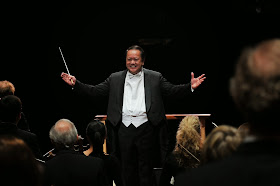By Erica Miner
The final offering of the 2014-15 San Diego Jacobs Masterworks series this weekend featured Music Director Jahja Ling conducting two weathered favorites and one lesser-known but appealing work. Beethoven’s somber, deeply introspective Piano Concerto No. 3, played with stunning virtuosity by Stephen Hough, was bookended by the otherworldly Musica Celestis for string orchestra by Aaron Jay Kernis and the earthly but radiant Brahms Symphony No. 2, thus closing the season on an optimistic, sunlit note.
Kernis, whose String Quartet No. 2 won the Pulitzer Prize in 1998, based Celestis on the slow movement of his 1990 String Quartet No. 1. The 11-minute piece provided ample opportunity for the outstanding solo players within the SDS string sections to shine, both celestially and instrumentally. Using a spectrum of colors and effects in all ranges, the composer painted an atmosphere of tranquility in the initial and closing episodes, while adding streaks of lightning-quick virtuoso passages in the middle section. Shades of the Prelude to Act 1 of Wagner’s Lohengrin in the always-brilliant key of A major during the opening, sprinkled with hints of Samuel Barber’s Adagio for Strings, metamorphosed into a unique work in which Kernis’ distinctive style predominated. In his first time conducting this work with SDS, Ling gently and expansively encouraged the SDS strings to generate their characteristic shimmering sound, thus enhancing the aural vision of heavenly loveliness.
Beethoven likely was in the throes of working on his only opera Fidelio when he premiered his third piano concerto in C minor in 1803. Certain melodic and rhythmic patterns from the opera are hinted at during throughout the concerto, but most overwhelming are the similarities to Mozart’s C minor piano concerto No. 24, one of only two that Mozart wrote in a minor key (the other was his D minor concerto, No. 20).
Renowned pianist Stephen Hough’s performance brought to mind all of these elements and more. The directness of his precise technique cleared the way for the melodies and rhythms to emerge from the fiendishly difficult technical challenges to present a crystalline succession of musical patterns without overemphasizing the aggressive nature of either the key or the work as a whole. His command and knowledge of the work and of Beethovenian style, coupled with his versatile background as a performer, writer and composer, produced a rendering that was at once technically proficient and erudite. Ling provided a solid foundation for the soloist in his balanced, well-defined accompaniment.
As Beethoven was inspired, and perhaps intimidated, by Mozart, Brahms had a hard act to follow in his symphonic giant of a predecessor. However, once Brahms had completed his elegiac C minor Symphony No. 1, he seemed to have freed himself of the burden he had felt from Beethoven’s presence by creating the sunlit, pastoral atmosphere of his Symphony No. 2 in D major.
In his capacious rendering of the Brahms, Ling opened up the cloud covered atmosphere established by the melancholy Beethoven concerto to let in one after another ray of musical sunshine, and his orchestra responded with a performance that justifiably electrified the audience. One would never have known that this was the first time Ling was performing the work with his orchestra in a Masterworks series. His background and knowledge of European tradition in composition and performance were keenly in evidence as, conducting without a score, he built the magnificence of the piece layer by layer until the full power of the orchestral forces burst forth in a wave of ebullient virtuosity, allowing the optimism of the work to shine through. The outstanding French horn section was at the forefront of the stirring playing displayed by the orchestra as a whole.
This lively, upbeat season finale paved the way for an upcoming season that promises more excitement on stage for Ling and his gifted ensemble, with works old and new, seasoned and lesser known but promising artists. After a performance such as was heard this weekend, there is much to look forward to in the fall.
Tickets for the upcoming San Diego Symphony Masterworks season are available at: http://www.sandiegosymphony.org/tickets-events/2015-16-season/jacobs/subscription/.
Photos used by permission of: Brianna Houston/Christian Steiner
Erica Miner can be reached at: [email protected]



No comments:
Post a Comment
Note: Only a member of this blog may post a comment.